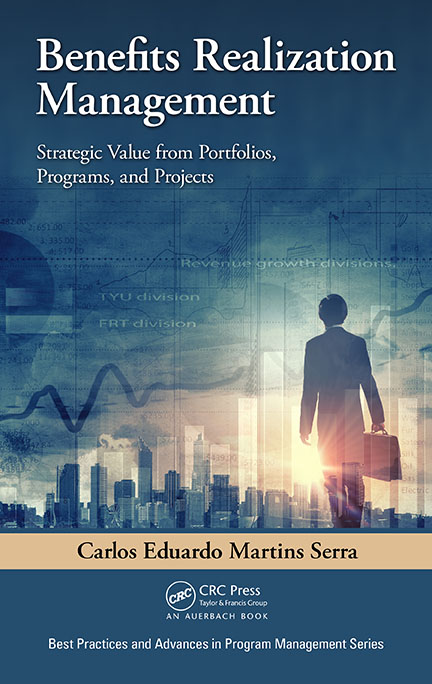
The Subject: Benefits Realization Management
Benefits Realization Management (BRM) is a key part of governance. BRM is a set of processes, tools and techniques. It supports the strategic creation of value for organisations. It provides also the correct level of prioritisation and executive support to ensure the success of the correct set of investment initiatives. Because of its relevance to the governance process, research identified BRM practices having a strong influence over project success. It has been also identified as a link between strategic planning and strategy execution.
The value for practitioners
This book guides portfolio, program, and project managers through the process of benefits realisation management so they can maximize the creation of value to the business. It discusses why and how programs and projects are expected to enable value creation, and it explains the role of BRM in value creation. The book provides a flexible framework for:
- Translating business strategy drivers into expected benefits;
- Composing a program and project portfolio that can realise expected benefits;
- Planning the benefits realisation expected from programs and projects and then making it happen;
- Keeping programs and projects on track, so that they enable the realisation of the expected benefits;
- Reviewing and evaluating the benefits achieved or expected against the original baselines and the current expectations.
The value for business managers
The book is not only designed to help project, program, and portfolio managers on their BRM journey, but also to support business managers in successfully executing business strategies. It explains the links built by the BRM techniques between business strategy and project, programme and portfolio management that enable more efficient and effective strategy execution.
In order to support the development of an organisational structure that supports an effective BRM process, the book identifies key organisational responsibilities and roles involved in BRM practices, and it provides a simple reference that can be mapped against any organisational structure.
How-to guide with examples and templates
A detailed and comprehensive case study illustrates each phase of the BRM framework as it links business strategy to project work, benefits, and business value. It makes easier to both students and practitioners to understand how the techniques that are mentioned in the book can be applied in an organisational environment.
Each chapter ends with a series of questions that provide a BRM self-assessment. The book also recommends additional bibliography to support further learning about each chapter. The book concludes with a set of 19 templates and detailed instructions to ensure successful deployment of the BRM tools and techniques.
Is the book based on Experience only or based on Research only?
The book is a result of the author’s 16+ years’ experience as a project, programme and portfolio management practitioner combined with several years of academic research.
Primarily, the book focuses on explaining how to implement and how to utilise BRM good practices that have been developed and employed by practitioners all around the world,
Secondarily, but not less important, an academic component comes into place to provide the background, rationale and sometimes evidence of the effectiveness of such practices. Since several academics around the world have been developing new BRM techniques and studying the application of BRM good practices, it is important to take their findings into consideration when assessing the relevance and effectiveness of each practice. This approach reassures the value of practices described in the book.
Therefore, the practices and templates mentioned in the book are the result of a combination of a lot experience with a lot of research.
What is the value of this book for the Project Management profession?
Benefits Realization Management: Strategic Value from Portfolios, Programs, and Projects is the result of around five years of work. It started as part of Carlos Eduardo Martins Serra‘s award winning research on the subject at the University of Warwick that provided the first yet academic evidence that benefits realization management practices influence project success and resulted on the landmark article Benefits Realisation Management and its influence on project success and on the execution of business strategies.
In order to achieve unbiased results, the collection of best practices analysed should be methodology agnostic. It means that hundreds of sources of information from various authors, countries, professional organisations and bodies of knowledge were studied. After the conclusion of the academic research, the author has further evolved the content to gradually make it the most comprehensive collection of Benefits Realization Management best practices that has been produced to date. It resulted in a 276 pages’s book that provides practitioners and academics with more than only theory and good practices, but includes also an easy-to-use set of templates, an illustrative case study and more.
To ensure high quality, the book was then subject to a thorough revision by the legendary Dr Ginger Levin, edited by John Wyzalek, and then it published by CRC Press as part of the series Best Practices and Advances in Program Management.
How can you buy a copy of the book?
The book has been published by CRC Press (a member of the Taylor & Francis Group) and has been distributed worldwide. The CRC Press online store ships the book to any country for free. You can also find the book in several other stores (e.g. Amazon.com). The electronic version is going to be released soon, so watch this space.
Now, why don’t you find out more about the book by following one of these this links to the CRC Press Online Store or to the Amazon online store? I hope you enjoy it.
Links to by directly from the publisher:
- Link to buy a Hardback copy from the CRC Press online store
- Link to buy the ebook version from the CRCnetBASE online store
Links to other websites and resellers:
- Links to buy the Kindle version from Amazon UK, or Amazon USA
- Link to buy the ebook version from VitalSource
- Link to download a sample introduction from IT Today
